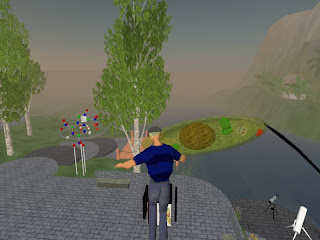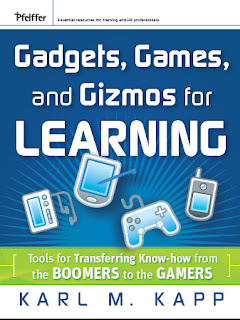This month the Big Question on the Learning Circuit’s blog has to do with rapid e-learning.
“What are the trade offs between quality learning programs and rapid e-learning and how do you decide?”
I have done some previous writing on the topic of rapid e-learning:
Learning at Byte SpeedSpeed is King: Rapid Creation and Deployment of Enterprise E-Learning SolutionsAlso, call it fate or good timing, I have just been interviewed on this very topic for the February issue of
T&D Magazine. So you can read more of my thoughts on rapid e-learning in the magazine. In the meantime, here is a sneak preview.
Just because we have developed tools to create e-learning rapidly…that doesn’t mean we can design effective learning more quickly than in the past. In fact, what most often passes for rapid e-learning is a poorly designed slide show presentations developed at a moment’s notice with bullets and a bad voice over from a rushed trainer or developer.
A good example of the forces at work to push rapid e-learning is given by
Howard Cronin. His post sums up some of the pressures we get from management. Often training professionals are not given the same time frame as software developers or others and then we are told to develop training at the last minute and, like dutiful soldiers, we develop it at the last minute (we have too or be out of a job). Unfortunately, the thinking from us and management seems to be “It isn’t what we want, it isn’t really effective but…hey its done.”
And, since our industry does a horrible job of evaluating our successes (or lack thereof) no one checks...so everyone is seemingly happy.
To me one of the most telling comments on this entire topic was posted by Will Thalheimer in a post titled
Simple Performance Improvement. Check the Clock. Will reports on an article indicating that doctors who take longer to perform a critical procedure to identify potentially cancerous polyps during a routine colonoscopy find more polyps than doctors who rush through. It seems so obvious...but...The lesson, speed is not always a virtue. But for some reason we think it is a virtue in and of itself.
But I do believe that Yes, we can reduce the DEVELOPMENT time but I am not sure we can reduce the design time.
Design is the “secret sauce” that we instructional designers should be adding to the sea of information that surrounds our internal and external clients. Only we (if you believe we are skilled professionals) can identify the content to be learned and then, using instructional strategies, research and proper instructional sequencing… design instruction that helps learners retain the information they are to learn. We design conceptual lessons with examples and non-examples, we teach procedural knowledge through decomposition and other strategies.
We should applaud the reduction in time for the development process of creating e-learning. But we should not allow for a reduction in DESIGN time. I know that designers face the issue of push back from clients all the time and, as
Wendy Wickham, has mentioned before…not everyone is in the positon to push back. So, I don't want to seem too ivory tower...but are we getting short term relief while courting longer term problems (hey, it only took you 2 weeks for the last e-learning module…do this one in a week and a half)
Trade OffsSo what are the trade offs, well we have three general areas, Quality, Speed and Cost (really four, see below)
When we rapidly develop e-learning we often eliminate motivational aspects of the instruction, we often eliminate sound instructional strategies. We often remove context such as the use of scenarios or case studies, we often reduce the amount of feedback provided to the learner, we reduce the amount of analysis we do to make sure we are even creating instructional that is valuable in the first place. Sometimes we even just copy and paste from the procedure manual.
Rapid e-learning is not impossible to do effectively, we just need to be rational about the word “rapid” and I completely agree with
Clive Shepherd when he writes;
Who says e-learning materials that take a long time to produce are necessarily high quality, let alone relevant or effective?
So, maybe the real question is how to we balance quality, speed and cost, and, I will add, learning. I think of these items as sliders on a stereo system (if anyone remembers those) we have to seek balance by moving the sliders to the right and to the left to seek the right balance.
So the trade offs are many, the answers are not simple but we must strive to inform all of our stakeholders that when one slider is pushed to the far end in one direction, another slider is pushed to the far end in the opposite direction and the results may not be pretty.
__
Recommended Games and GadgetsRecommended BooksContent Guide



















 It says that he is Fast, Athletic and Flirtatious. He does run cross-country and he does like all kinds of sports. But what has me worried is the Flitratious. He is just about 13 and certainly has girls on his radar. HMMM, I'd better keep and eye on the Flash.
It says that he is Fast, Athletic and Flirtatious. He does run cross-country and he does like all kinds of sports. But what has me worried is the Flitratious. He is just about 13 and certainly has girls on his radar. HMMM, I'd better keep and eye on the Flash.












